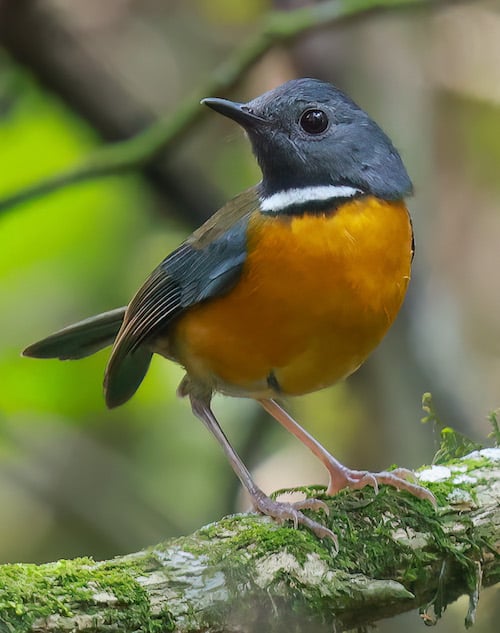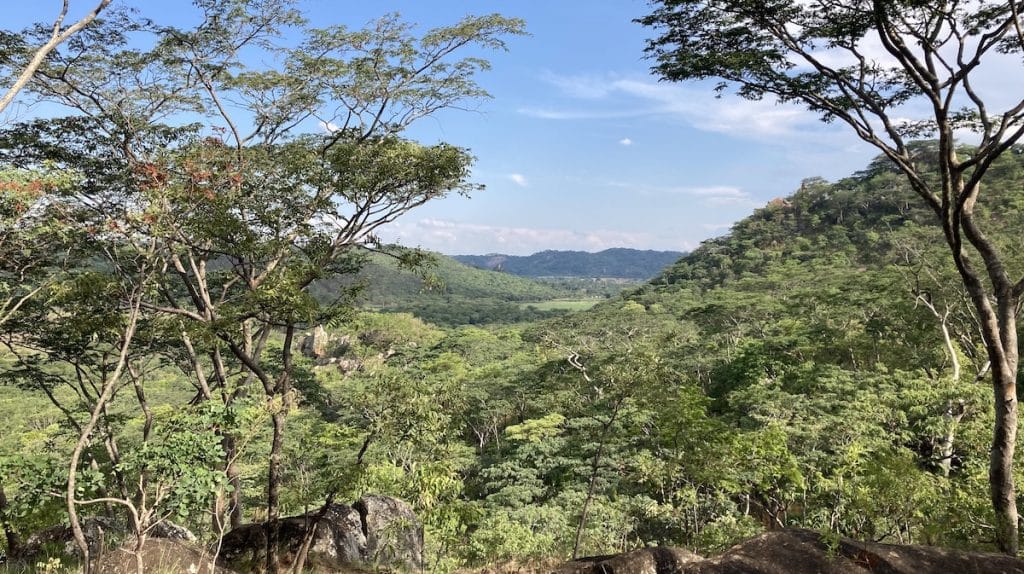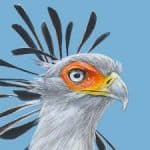Republic of Zimbabwe

Zimbabwe is a landlocked country in Southern Africa, between the Zambezi and Limpopo Rivers, bordered by South Africa to the south, Botswana to the southwest, Zambia to the north, and Mozambique to the east. The capital and largest city is Harare, and the second largest is Bulawayo. It has a population of c.15 million people of whom the largest ethnic group are the Shona, who make up 80% of the population, followed by the Northern Ndebele and other smaller minorities. Zimbabwe has 16 official languages, with English, Shona, and Ndebele the most common.
Most of the country is elevated, consisting of a central plateau (high veld) stretching from the southwest northwards with altitudes between 1,000m and 1,600m. The country’s extreme east is mountainous, this area being known as the Eastern Highlands, with Mount Nyangani as the highest point at 2,592m. The highlands are known for their natural environment, with tourist destinations such as Nyanga, Troutbeck, Chimanimani, Vumba and Chirinda Forest at Mount Selinda. About 20% of the country consists of low-lying areas, (the low veld) under 900m.
Victoria Falls, one of the world’s largest and most spectacular waterfalls, is located in the country’s extreme northwest and is part of the Zambezi river. Zimbabwe has a subtropical climate with many local variations. The southern areas are known for their heat and aridity, while parts of the central plateau receive frost in winter. The Zambezi valley is known for its extreme heat, and the Eastern Highlands usually experience cool temperatures and the highest rainfall in the country. The country’s rainy season generally runs from late October to March, and the hot climate is moderated by increasing altitude. Zimbabwe is faced with recurring droughts.

Southern Miombo Woodland ©Dominic Rollinson
Zimbabwe contains seven terrestrial ecoregions: Kalahari acacia-baikiaea woodlands, Southern Africa bushveld, Southern miombo woodlands, Zambezian Baikiaea woodlands, Zambezian and mopane woodlands, Zambezian halophytics, and Eastern Zimbabwe montane forest-grassland mosaic in the Eastern Highlands. The country is mostly savanna, although the moist and mountainous Eastern Highlands support areas of tropical evergreen and hardwood forests. Large parts of Zimbabwe were once covered by forests with abundant wildlife. Deforestation and poaching have reduced the amount of wildlife. Woodland degradation and deforestation caused by population growth, urban expansion and use for fuel are major concerns and have led to erosion which diminishes the amount of fertile soil. Local farmers have been criticised by environmentalists for burning off vegetation to heat their tobacco barns.
Birding Zimbabwe
There are around 350 species of mammals that can be found in Zimbabwe. There are also many snakes and lizards, 131 fish species and over 700 species of birds, the majority of which are easily accessible by vehicle, boat or on foot. The best time to visit is October to March as most of the Palaearctic and intra-African migrants are present. However, the cooler and dryer months of May to August will enable the keen spotter to concentrate on local species. There are some small companies in the country specialising in bird safaris, and about 8-10 knowledgeable bird guides country-wide. The country can be split into 4 major areas, each with its own population of birds.
Montane & Eastern Border Blue-spotted Dove, Scarce Swift, Stripe-cheeked Bulbul, Swynnerton’s Robin, Chirinda Apalis, Moustached Warbler, Singing Cisticola, Short-winged Cisticola, Red-winged Warbler, Briar (Robert’s) Warbler, White-tailed Flycatcher, Black-fronted Bush Shrike, Bronze Sunbird, Yellow-bellied Sunbird, Fire-crowned Bishop, Red-faced Crimsonwing, East African Swee.
Zambezi Valley Western Banded Snake-Eagle, Long-toed Plover, Rock Pratincole, African Skimmer, Lilian’s Lovebird, White-browed Coucal, Collared Palm Thrush, Livingstone’s Flycatcher.
Central Plateau Streaky-breasted Flufftail, Black Coucal, Spotted Creeper, Pink-throated Longclaw, Miombo Double-collared Sunbird, Violet-backed Sunbird, & Locust Finch.
Western Kalahari Burchell’s Sandgrouse, Yellow-throated Sandgrouse, Bradfield’s Hornbill, Pied Babbler, Kalahari Scrub Robin, Yellow-billed Oxpecker.
Country-wide (southern-African birds centred in Zimbabwe) Taita Falcon, Grey-headed Parrot, Pel’s Fishing Owl, Pennant-winged Nightjar, Mottled Swift, Mottled Spinetail, Bohm’s Spinetail, Slender-billed Honeyguide, Mosque Swallow, Eastern Saw-wing Swallow, White-breasted Cuckooshrike, Northern Grey Tit, Miombo Rock Thrush, Arnot’s Chat, Boulder Chat, Mashona Hyliota, Red-faced Crombec, Tropical Boubou, Long-tailed Starling, Lesser Blue-eared Starling, Coppery Sunbird, Yellow White-eye, Yellow-backed Widow, Golden-backed Pytilia, Red-throated Twinspot, Broad-tailed Paradise Whydah, Black-eared Canary, Cabanis’s Bunting.
Northwest Triangle (Victoria Falls) Slaty Egret, Schalow’s Lourie, Coppery-tailed Coucal, Swamp (Natal ssp) Nightjar, White-rumped (Hartlaub’s) Babbler, Greater Swamp Warbler, Luapula (Black-backed ssp.) Cisticola, Chirping Cisticola, Marsh (Cape ssp.) Wagtail, Swamp Boubou, Burchell’s Starling, Brown-throated Weaver, Red-shouldered Whydah, Brown Firefinch, and at certain times of the year Pygmy Goose, Lesser Jacana, Long-billed (Ethiopian ssp) Snipe, Rock Pratincole, African Skimmer, Shelley’s Sunbird and Redheaded Quelea.
As can be seen from the list above, most of the special Okavango species can be seen easily at Kazungula swamp – a private safari area – west of Victoria Falls and at less cost in money and time than travelling to Okavango (between 200-300 species have been noted there each month).
The Victoria Falls area of about 2500 sq. km boasts a bird-list now exceeding 450 species annually and the Hwange National Park is 100km south of Victoria Falls where there are other species not found further north.
-
Number of bird species: 708
(As at March 2024)National Bird: African fish Eagle Haliaeetus vocoder
-
African Bird Club
Checklist PDFThis checklist has been developed for use by ornithologists, birdwatchers and others with a general interest in African birds. It is based on that published on the ABC website up to 2016 and has been revised significantly with the addition of new information and the use of IOC taxonomy. -
Avibase - The World Bird Database
Checklist -
BirdLife Zimbabwe
Checklist
-
Newman's Birds of Southern Africa
| By Kenneth B Newman, Faansie Peacock & Vanessa Newman | Random House Struik | 2010 | Paperback | 536 pages, plates with colour illustrations; colour photos, colour distribution maps | ISBN: 9781770078765 Buy this book from NHBS.com -
Roberts Bird Guide
| By Hugh Chittenden, Greg Davies & Ingrid Weiersbye | Jacana Publishers | 2019 | Hardback | 570 pages, plates with colour illustrations; colour photos, colour distribution maps | ISBN: 9781920602024 Buy this book from NHBS.com -
SASOL Birds of Southern Africa
| By Ian Sinclair, Phil Hockey, Warwick Tarboton, Peter G Ryan, Norman Arlott & Peter Hayman | Random House Struik | 2020 | Edition 5 | Paperback | 482 pages, 3000 plates with colour illustrations; colour distribution maps | ISBN: 9781775846680 Buy this book from NHBS.com -
Southern African Birdfinder
| (Where to find 1400 bird species in southern Africa and Madagascar) | By Callan Cohen, Claire Spottiswoode & Jonathan Rossouw | New Holland Publishers | 2006 | Paperback | 456 pages, 80 col photos, 100 maps, pull-out route map | ISBN: 9781868727254 Buy this book from NHBS.com -
Stuarts' Field Guide to National Parks & Game Reserves Namibia, Botswana, Zimbabwe, Zambia, Malawi
| By Chris Stuart & Mathilde Stuart | Penguin Random House South Africa | 2022 | Paperback | 320 pages, 1100 colour photos, 46 colour maps | ISBN: 781775847205 Buy this book from NHBS.com

Roberts Bird Guide 2
Apple iOS | AndroidROBERTS BIRD GUIDE 2 iap is based on the book "Roberts Bird Guide (second edition)" with new illustrations, distribution maps and bird texts for 990 Southern African bird species, including new species and names, and new app functions and features. You can download a sample version and use in-purchase for a light or full version. ROBERTS BIRD GUIDE 2 is based on the "Roberts Bird Guide (second edition)" with all new illustrations, distribution maps and bird texts for 986 Southern African bird species, including all the new species and names. The app can be used as a FIELD GUIDE like the book, or as a BIRD GUIDE with bird list and bird pages.Useful Information-
Zimbabwe
InformationZimbabwe supports significant populations of 14 species of global conservation concern (Collar et al. 1994). Eight of these are globally threatened: Sarothrura ayresii, Gyps coprotheres, Falco naumanni, Falco fasciinucha, Grus carunculatus, Crex crex, Hirundo atrocaerulea and Swynnertonia swynnertoni. The first-mentioned is Endangered, and the rest are Vulnerable. The other six species are globally Near Threatened: Ardeola idae, Phoenicopterus minor, Circaetus fasciolatus, Circus macrourus, Gallinago media and Anthreptes reichenowi. In addition, there are various other species which are vulnerable in a national context and need conservation action, such as Struthio camelus, Bucorvus cafer and Buphagus africanus...
Museums & Universities-
Natural History Museum of Zimbabwe
WebsiteThe department of Ornithology boasts of a very comprehensive collection of birds and is the largest collection of bird skins in Africa and the fourth largest biggest in the world after those at The British Museum in Tring, The Museum of Central Africa in Belgium and the American Museum of Natural History.
Organisations-
African Bird Club
WebsiteZimbabwe has a confirmed bird list of over 660 species so far and new vagrants continue to be spotted. It is unlikely that any new species resident in the country will be found unless they are created by splitting present species. The best birding areas have been well covered. Even today most are accessible to the birder, but the availability of fuel can limit travel. Although there are no endemic species in Zimbabwe, some are restricted to the forests of the eastern highlands and western Mozambique e.g. Chirinda Apalis Apalis chirindensis. -
BirdLife Zimbabwe
WebsiteBirdlife Zimbabwe - A Partner Designate of BirdLife International - P O Box RV 100, Runiville, Zimbabwe or 35 Clyde Road, Eastlea, Harare or 3A Holdengarde Ave, Hillside, Bulawayo, Zimbabwe Telephone: 263 4 490208 e-mail - birds@zol.co.zw or adrienne@mweb.co.zw -
Hwange Conservation Society
WebsiteThe Hwange Conservation Society was established in 1992 to help protect the wildlife and environs of the Hwange National Park - Wankie as it used to be known in Zimbabwe, formely Rhodesia
Reserves-
*Zimbabwe National Parks
InformationSatellite ViewAnnotated list -
BR Middle Zambezi
InformationSatellite ViewThe 2,879,300 hectares (11,117 sq mi) reserve consists of riverine and terrestrial ecosystems unique to the subcontinent. -
IBA Lake Chivero
InformationSatellite ViewThe lake and hinterland are protected as part of Lake Chivero Recreational Park. The lake was designated a Ramsar wetland of international importance on 3 January 2013. There is a great variety of birdlife and for the birdwatcher, the park is a paradise, Included amongst the several bird species are: South African ostrich, African openbills, barbets, bee-eaters, buzzards, coots, cormorants, doves, hamerkops, jacanas, kingfishers, grey herons, darters, Goliath herons, fish eagles, glossy starlings and lilac-breasted rollers. -
IBAs
WebpageSatellite ViewThe eastern highlands along the border with Mozambique form a major part of the globally important Eastern Zimbabwe Mountains Endemic Bird Area (EBA) which has a number of near endemic species such as Swynnerton -
NP Chizarira
InformationSatellite ViewChizarira National Park lies in Northern Zimbabwe. At 2,000 square kilometres (490,000 acres), it is the third-largest national park in Zimbabwe, and also one of the least known because of its isolated situation on the Zambezi Escarpment. Chizarira has a large variety of bird life and hundreds of species have been sighted within the Park. Sought after birds recorded include the African broadbill, Livingstone's flycatcher, yellow-spotted nicator, African emerald cuckoo and the rare and elusive African pitta. Chizarira is also home to the Taita falcon which breeds within the Park. -
NP Gonarezhou
InformationSatellite ViewAt 5,053 km2, Gonarezhou is the country's second largest game reserve after Hwange National Park. -
NP Hwange
InformationSatellite ViewHwange National Park is one of Africa's finest havens for wildlife and is home to vast herds of elephant, buffalo, zebra and has a very large concentration of giraffe. It is also home to many predators and endangered species plus very large and varied birdlife of over 400 species… -
NP Kazuma Pan
InformationSatellite ViewKazuma Pan is virtually unspoilt wilderness with an open landscape of grassy plains which is reminiscent of the great East African plains and is thus dissimilar to the usual Zimbzbwen bush or woodland landscapes. Within the Park there are a series of pans, some of which are kept continuously filled by water pumped from boreholes during the dry season. This permanent water source causes large concentrations of wildlife to seasonally migrate between Botswana and Zimbabwe, especially towards the end of the dry season from September through to the first rains of November or December. There are a series of seasonally flooded pans in the south-west of the park attracts a wide variety of waterfowl. The pan systems are also ideal habitat to a large variety of water birds, with a number of species including storks, crowned cranes, stilts, cormorants, ducks and kingfishers occurring throughout the area. -
NP Mana Pools
InformationSatellite ViewMana Pools National Park is synonymous with the Zambezi River, elephants, lions, remoteness and wilderness. -
NP Matobo
InformationSatellite ViewThe Matobo National Park forms the core of the Matobo or Matopos Hills, an area of granite kopjes and wooded valleys commencing some 35 kilometres (22 mi) south of Bulawayo, southern Zimbabwe. Matobo National Park contains the highest concentration of black eagles, and breeding pairs of these birds, worldwide. -
NP Matusadona
InformationSatellite ViewMatusadona National Park is a national park in northern Zimbabwe situated on the southern shore of Lake Kariba. Its area encompasses a combination of pristine and rugged wilderness, which before the Kariba Dam was built and Lake Kariba created was very inaccessible. The creation of the lake caused profound ecological changes. In particular, the availability of grazing on the lakeshore has contributed to an increase in the populations of large mammals large mammal in the park, especially those of elephant and Cape buffalo. -
NP Nyanga
InformationSatellite ViewIt contains the highest land in Zimbabwe, with green hills and perennial rivers. Most of its terrain consists of rolling downland, sometimes lightly wooded, lying at altitudes between 1,800–2,593 metres (6,560–7,544 feet). Mount Nyangani, the highest point in Zimbabwe, lies in the centre of the park and Mutarazi Falls, Zimbabwe's highest waterfall, is in the south of the park. Nyanga National park incorporates the former Mutarazi Falls National Park on its southern boundary. -
NP Victoria Falls
InformationSatellite ViewA notable feature of the park is the rainforest which grows in the spray of the falls, including ferns, palms, liana vines, and a number of trees such as mahogany not seen elsewhere in the region. The park is located within the Zambezian and Mopane woodlands ecoregion. -
NP Zambezi
InformationSatellite ViewZambezi National Park is a national park located upstream from Victoria Falls on the Zambezi River in Zimbabwe. It was split off from Victoria Falls National Park in 1979 and is 56,000 hectares (140,000 acres) in size. The park is bisected by a road to Kazungula, dividing it into a riverine side and a Chamabonda Vlei side. Most of the park is within the ecoregion of Zambezian and Mopane woodlands, while a small portion in the south is within the Zambezian Baikiaea woodlands. Over 400 species of birds have been recorded within the Zambezi National Park. Pel's fishing owl, African skimmer, collared palm thrush, lanner falcon, goliath heron, African finfoot, rock pratincole and long-toed lapwing are considered to be among the speciality birds of the park. -
TFP Great Limpopo Transfrontier Park
InformationSatellite ViewGreat Limpopo Transfrontier Park is a 35,000 km² peace park that is in the process of being formed. It will link the Limpopo National Park (formerly known as Coutada 16) in Mozambique, Kruger National Park in South Africa, Gonarezhou National Park, Manjinji Pan Sanctuary and Malipati Safari Area in Zimbabwe, as well as the area between Kruger and Gonarezhou, the Sengwe communal land in Zimbabwe and the Makuleke region in South Africa.
Guides & Tour Operators-
Afrizim
Tour OperatorBookings for Tours, Safaris and Lodges in Zimbabwe -
Birding Ecotours
Tour OperatorSee all the major habitats, sights and birds… and end up with a very good bird list and loads of Africa’s big and small mammals. Highlights include Mana Pools – one of Africa’s wildest game parks, the Mashonaland Plateau that boasts brilliant wetland and miombo birding, Matobo and Hwange National Parks, Great Zimbabwe Ruins, village of Victoria Falls and the spectacular eastern highlands and lowlands – an absolutely idyllic area which you’ll be sad to leave. -
Rockjumper Birding Tours
Tour OperatorFor obvious reasons, Zimbabwe has largely been ignored as a birding destination; however, with great species including two regional endemics, Chirinda Apalis and Robert’s Prinia, as well as Arnot’s and Boulder Chat, Swynnerton’s Robin and Red-faced Crimsonwing, the country is well worth a visit. Our tour of Zimbabwe targets all these species and much more besides.
Trip Reports-
2016 [12 December] - Dylan Vasapolli - Zimbabwe & Mozambique
PDF ReportThis exciting tour takes us into the heart of Zimbabwe and Mozambique. While thesecountries possess very few truly endemic species, they provide relatively easy access to anumber of species that are very difficult elsewhere in their range while remaining ‘easy’ here.Species such as Boulder Chat, Green-backed Honeybird, Cinnamon-breasted Tit,White-chested Alethe, East Coast Akalat, Lowland Tiny Greenbul, Chestnut-frontedHelmetshrike, and African Pitta, among others, are all prime examples... -
2018 [09 September] - Dominic Rollinson
PDF ReportThis 21-day trip of Namibia, Botswana, Zimbabwe, and Zambia was a customized trip for Susan and Aileen from the Republic of Ireland, which started in Walvis Bay, Namibia, on 20 August 2018 and ended in Livingstone, Zambia, on 9 September 2018. -
2018 [11 November] - Chris Lotz
PDF ReportThis comprehensive tour consisted of three legs, first a pre-trip to Mana Pools National Park in northern Zimbabwe, followed by our set-departure eastern Zimbabwe and central Mozambique tour, and last a post-trip traveling back to Johannesburg from Beira, birding along the way. -
2023 [12 December] - Bill Simpson - Malawi, Zambia & Zimbabwe
PDF Report -
2023 [12 December] - Dominic Rollinson
PDF ReportWe started in Harare, where we birded nearby miombo woodlands and open floodplains which kickstarted our bird list with the likes of Boulder Chat, African Spotted Creeper, Green-backed Honeybird, Miombo Rock Thrush and Wood Pipit, before we made our way to the picturesque Eastern Highlands (adding Blue Swallow en route). As always, the birding here was excellent as we found various forest specials such as Swynnerton’s Robin, Red-faced Crimsonwing, Chirinda Apalis, Roberts’s Warbler, Orange Ground Thrush, White-tailed Crested Flycatcher, Silvery-cheeked Hornbill, Black-fronted Bushshrike, Buff-spotted Flufftail and had brief views of the most-wanted Lesser Seedcracker. Some lower altitude specials seen away from the forests included Marsh Tchagra, Moustached Grass Warbler, Red-winged Prinia and Black-winged Bishop. -
2023 [12 December] - Dylan Vasapolli
PDF ReportThis private tour was specifically designed around seeing the mythical African Pitta, for a couple (Sue and John). While the pitta was the main target, there were several other possibilities that were factored in, like Bronze-winged Courser, Lilian's Lovebird and African Wild Dog, amongst others. As such, we quickly settled on a custom tour to Zimbabwe, where we would focus our time on the amazing Mana Pools National Park. Mana Pools is located in the Zambezi River valley of far northern Zimbabwe, this big game park is one of Africa’s premier wildlife destinations, and we would base ourselves here for six nights, to give ourselves the best possible chance of success. A few extra days were also added on around Harare, to try for some of the miombo woodland targets that were possible, notably Boulder Chat and Whyte’s Barbet.
Blogs-
Brent Stapelkamp - The Hwange Birder
BLOGHwange National Park and her birds have been forgotten in recent years and I hope that this blog may go some way to re-sparking interest in the two. Hwange has two main seasons, one hot and wet season starting in mid November and ending in mid April. This is the season for migratory birds in Hwange ranging from the inter-African migrants like the Southern Carmine Bee-eater to the Palearctic Migrants like the Amur Falcons and the Ruff. The Hwange bird list is said to be about 400 species and this is largely due to these migrants that take advantage of the huge numbers of insects and associated opportunities during our wet season.
-
Fatbirder - linking birders worldwide... Wildlife Travellers see our sister site: WAND
Skip to content

